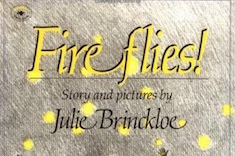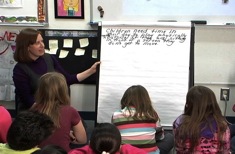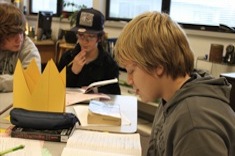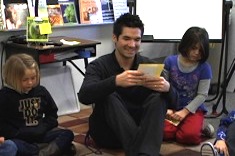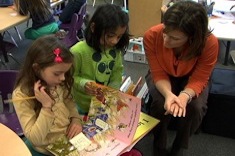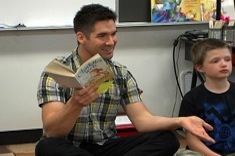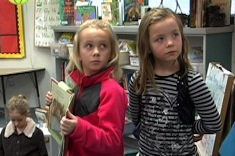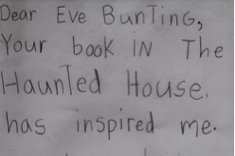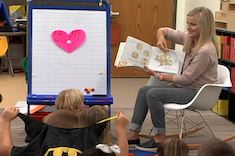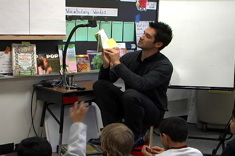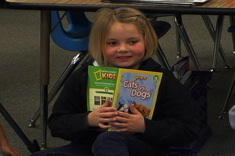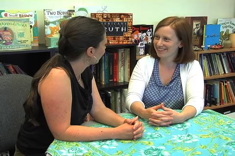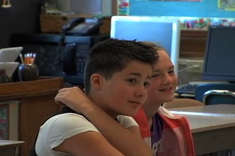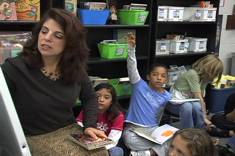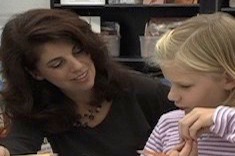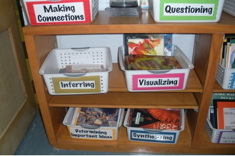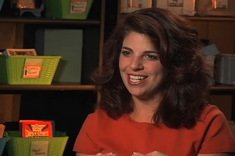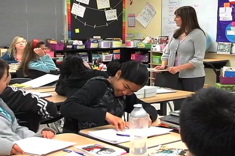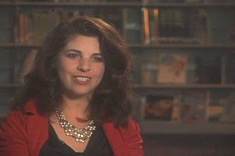Mentor Texts
It's all about the right book at the right time, given to the right student or used in the right lesson . . . Here is where we gather all those suggestions from our contributors for using mentor texts, including lesson protocols and scores of video examples.
Latest Content
Fireflies and Background Knowledge
Karen Terlecky writes about the importance of building understanding before more complex read alouds.
Subheading Literacy: Nothing “Sub” About It
Heather Rader discovers subheadings are a neglected but useful tool for teaching students about key topics in their writing.
Teacher-as-Writing-Model Minilesson in Fourth Grade
Beth Lawson models her process as a writer for her fourth-grade students, describing her emotions as well as creating a draft.
Just-Right Poetry and Individualizing Instruction
Shari Frost describes how a sixth-grade teacher provides a range of poetry options to meet the needs of all students.
Poetry and Fluency Minilesson in Second Grade
Sean Moore uses the poem “The Busy Ant” for partner work and discussion of fluency and vocabulary with his second graders.
Shared Reading to Explore Writer’s Craft in First Grade
Katie DiCesare’s first graders reread a favorite text in pairs to work on noticing the details of writer’s craft.
From “Show Me the Lessons” to Sustainable Planning (Part 4 of the Opinion/Argument Writing Series)
This is the final installment in Heather Rader's series on argument and opinion writing in the intermediate grades.
Second-Grade Writing: Adding Details and Descriptive Language
In this first video from a four-part series, Sean Moore leads a writing workshop focused on adding more details and descriptive language to writing. He begins with the classic Charlotte’s Web as his mentor text.
Launching a Punctuation Study in Second Grade
Linda Karamatic is launching a unit on punctuation with her second graders which includes mentor texts, inquiry, and anchor charts.
Dear Eve Bunting
A persistent seven-year-old has some powerful messages about confidence, patience, and sending writing out into the world.
Field Experience: Picture Books and Older Students
The value of picture books with older students is often questioned. Ruth Ayres assembled this field experience to allow insight into the depth and power of picture books for older students.
Writing, Graphic Organizers, and Mentor Texts
In this video from Sean Moore’s second-grade classroom, Sean demonstrates how to use a graphic organizer with his own writing as the mentor text.
Finding a Place for Graphic Novels in My Classroom
Katherine Sokolowski listens to her husband’s sage advice and develops a new relationship with graphic novels that disappear off her classroom shelves.
The Quest for the Perfect First Read Aloud of the Year
Franki Sibberson is on a quest to find the perfect first read aloud of the year, and the search helps her consider the goals and purpose of read alouds during the first days of school.
Nonfiction Read Aloud
Sean Moore reads nonfiction aloud to his 2nd grade students. This is the first video in a two-part series.
Nonfiction Read Aloud – Part 2
Here are some more tips for nonfiction read-alouds, based on Sean Moore's reading of Plants That Eat Animals.
Listen In: XBox Game Writing
Boys and their toys: Heather Rader confers with a second grader over his game writing while Linda Karamatic listens in.
Previewing Nonfiction
Teachers are adding more nonfiction to their classroom libraries, and looking for ways to promote nonfiction with students in light of the emphasis on nonfiction in the Common Core. Franki Sibberson share tips for previewing nonfiction with students.
Scaring Up Better Narratives Part 3
Aimee Buckner leads a lesson on brainstorming topics in writer's notebooks using the mentor text Some Things Are Scary. In this final installment of a three-part series, Aimee continues to confer with students and shares a great tip for nonfiction research.
Mentor Texts for Nonfiction Writing
Beth Lawson and Heather Rader meet to plan and share mentor texts for nonfiction writing in Beth’s fourth-grade classroom.
Scaring Up Better Narratives Part I
Just before Halloween, Aimee Buckner leads a lesson on brainstorming topics in writer's notebooks using the mentor text Some Things Are Scary. In this first installment of a three-part series, Aimee reads the book and models her own thinking process and use of a writer's notebook.
Scaring Up Better Narratives Part 2
Just in time for Halloween, Aimee Buckner leads a lesson on brainstorming topics in writer's notebooks using the mentor text Some Things Are Scary. In this second installment of a three-part series, Aimee continues to confer with students and helps everyone refine potential writing topics in their notebooks.
Making the Reading-Writing Connection with Genre Studies: The “Must Have” Lesson
No stranger to genre studies, Aimee Buckner has both advice and book basket ideas to get must-haves in your hands.
Mentor Texts for Organizing Writing
We think of mentor texts for teaching literary elements, but what about for organizing? Aimee Buckner describes how she selects books to demonstrate a range of ways to organize writing and help students make choices independently.
Rethinking Mentor Texts
Shari Frost writes about the ways our perfectly organized bins may limit the teaching possibilities for many books. She takes readers step by step through her process of determining ways to use a sample mentor text to teach a multitude of lessons and strategies.
Choosing Mentor Texts for Reading
In this quick take video, Aimee Buckner explains her criteria for selecting mentor texts for small-group, individual, and whole-class instruction.
Seedfolks: Connecting Community and Literature
There's so much to do during the first weeks of school, but it's important not to skip the most important thing – building a sense of community with your students.
Injecting Writing into Everything: Cover-up Stories
Cover-up stories involve removing illustrations to heighten awareness of other story elements. Heather Rader explains how the instructional technique works.
Quick Take: Selecting Mentor Texts for Writing Instruction
In this two-minute video, Aimee Buckner explains how she selects mentor texts for writing, as well as the importance of using writing by students and teachers in lessons.
Picture Books for Shared Reading
Shared reading builds skills and community in Katie DiCesare's 1st grade classroom.
Browse Content By
Type
Category
- Assessment Tools
- Big Fresh Archives
- Booklists
- Choice Numeracy
- Classroom Design
- Common Core
- Community Building
- Conferring
- Content Literacy
- Digital Literacy
- English Language Learners
- Equity
- Family Relations
- Free Samples
- Guiding Groups
- Leadership
- Literacy Coaches
- Mentor Texts
- Minilessons
- New Teacher Mentors
- Podcasts
- Poetry
- Quote Collections
- Reading Strategies
- Self Care
- Struggling and Striving Learners
- Talking and Listening
- Teacher Study Groups
- Teaching Reading
- Teaching Writing
- Word Study and Vocabulary
Author
- Melissa Quimby
- Nawal Qarooni
- Gwen Blumberg
- Julie Cox
- The Lead Learners
- Hannah Tills
- Josie Stewart
- Ruth Metcalfe
- Mallory Messenger
- Becca Burk
- Jodie Bailey
- Vivian Chen
- Mary Brower
- Tiffany Abbott Fuller
- Stephanie Affinito
- Ruth Ayres
- Leigh Anne Eck
- Heather Fisher
- Shari Frost
- Julie Johnson
- Suzy Kaback
- Gigi McAllister
- Shirl McPhillips
- Melanie Meehan
- Cathy Mere
- Debbie Miller
- Tara Barnett and Kate Mills
- Tammy Mulligan
- Dana Murphy
- Bitsy Parks
- David Pittman
- Brenda Power
- Heather Rader
- Matt Renwick
- Mandy Robek
- Christy Rush-Levine
- Gretchen Schroeder
- Jen Schwanke
- Brian Sepe
- Katherine Sokolowski
- Stella Villalba
- Jennifer Vincent
Grade Level
Choice Literacy Membership
Articles
Get full access to all Choice Literacy article content
Videos
Get full access to all Choice Literacy video content
Courses
Access Choice Literacy course curriculum and training

